
The Philippine Archipelago is known worldwide as the “Pueblo Amante de Maria” – The people in love of the Blessed Virgin Mary, for its strong devotion to the Blessed Virgin Mary that is persistent up to the present. Among all Marian devotions in the Philippines, one is the most persistent and important is the devotion to Mary as the Lady of the Immaculate Conception.
Every year, every December 8, the Solemnity of the Immaculate Conception is the principal Patroness of the Philippine Islands. Though after the suppression of several Church holy days in the Catholic Calendar of the Philippines, still, her feast stays as one of the three holy days of obligation during the year, the other two being Christmas and January 1, when the Solemnity of Mary, Mother of God, is celebrated. The devotion to her under this singular prerogative remained one of the strongest, from numerous pilgrims flocking to churches and shrines dedicated to her honor, holding grand fiestas and processions, and girls with the names “Concepcion” and its derivatives are still popular today, are clear evidence of the strength of the devotion in our country.
The Dogma
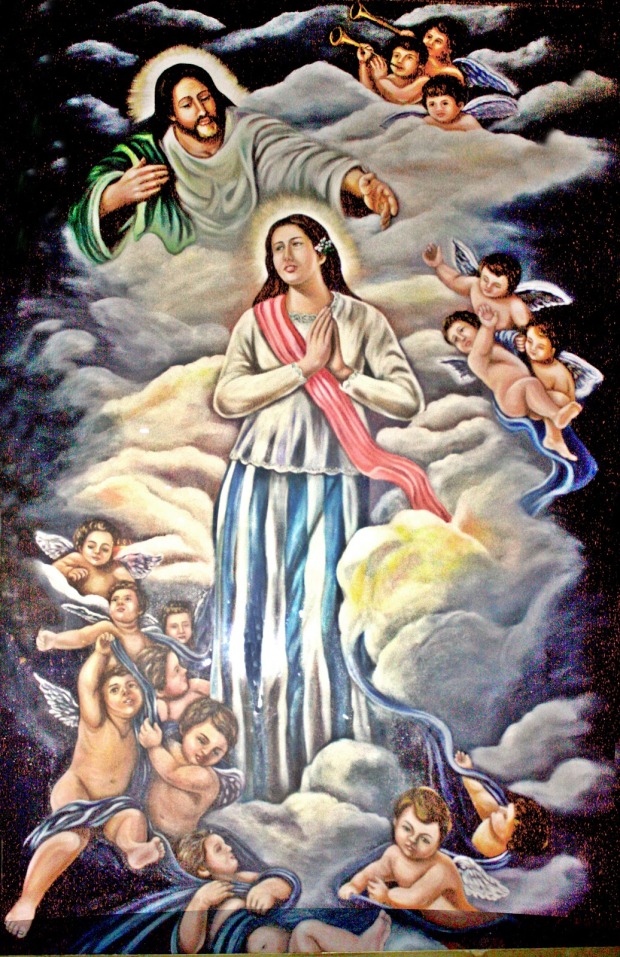
The Immaculate Conception is commonly confused with the Virgin Birth of Jesus. Jesus’s birth is covered by the Doctrine of Incarnation, while the Immaculate Conception deals with the conception of the Blessed Virgin Mary. The Immaculate Conception, according to the teaching of the Church, is the conception of the Blessed Virgin Mary free from original sin by the foreseen merits of her son Jesus Christ. The Church teaches that Mary was conceived in the womb of her mother, Saint Anne, but God acted upon her soul, keeping it “Immaculate”.
Scriptural Basis
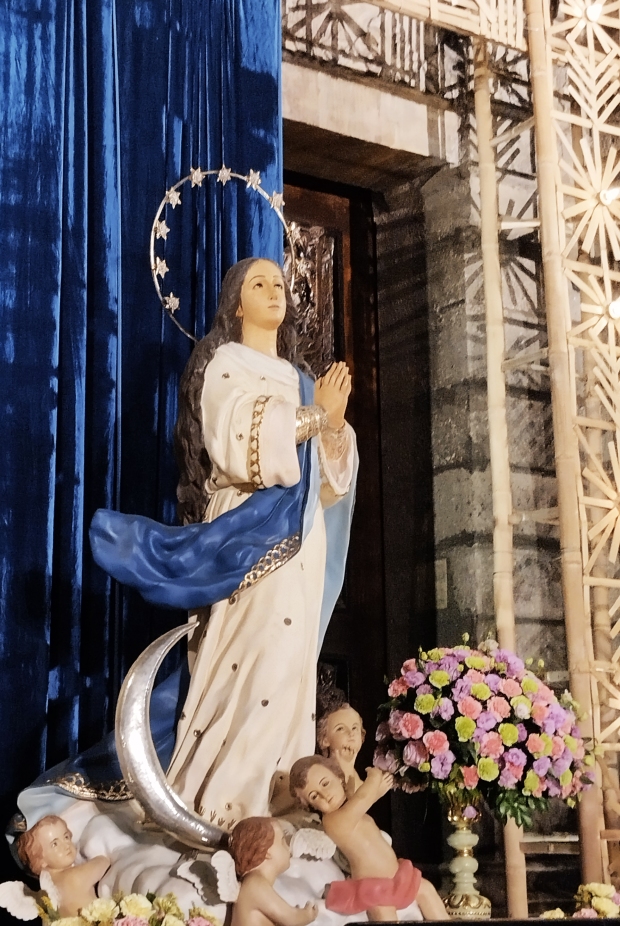
As used in the liturgy, in the Solemnity of the Immaculate Conception, two key biblical scenes emerged from the Old and New Testaments about the doctrine. In Genesis 3:15, Our Lord said: “I will put an enmity between you (the Serpent) and the woman and between your offspring and hers; He will strike at your head while you strike at his heel.” which narrates the victory over sin and death, through the woman, which is the Blessed Virgin Mary.
In the New Testament, a parallel text is to be found in the account of the Annunciation taken from the Gospel of St. Luke: “Hail, favored one! The Lord is with you.”, this greeting by the Archangel Gabriel was said to express the truth of the Immaculate Conception, i.e., that Mary could not be full of grace if she has been conceived in original sin.
This special privilege of Mary does not apply to the rest of humanity, nor is it derived from her nature, but is a special grace granted to her by God because of Christ. Mary’s singular grace of being immaculately conceived is based on her election by God to be the Mother of Jesus, the Redeemer of the World.
As the Mother of the Redeemer, she is the first to share primarily and especially in the salvific mission of her Son – liberation from sin. Her Immaculate Conception proves and affirms the victory of God’s loving goodness over sin which her Son totally manifested by becoming man.
The developments and arguments

Mary, the one who is “full of grace” and the one whom “all generations will be called ‘blessed” has been viewed as unique since the earliest days of the Christian faith. Just as Christ has been called the “new Adam,” the Church Fathers, especially Saints Justin (AD 150) and Irenaeus (AD 180), saw Mary as the “New Eve,” who humbly obeyed God, even though Eve disobeyed. The Church Fathers also called Mary the “new ark of the covenant” and Theotokos (The God-bearer). It is from these titles that the doctrine of Mary’s Immaculate Conception and sinlessness unfolded. Thus St. Ephrem the Syrian (d. AD 373) spoke of Mary as without stain or blemish, calling her “all-pure, all-immaculate, all-stainless, all-undefiled, all-incorrupt, all-inviolate” (see Nisibine Hymns, and “Precationes ad Deiparam”). St. Ambrose (d. AD 397) wrote “Lift me up not from Sarah, but from Mary, a Virgin not only undefiled but a Virgin whom grace has made inviolate, free of every stain of sin” (Commentary on Psalm 118).

The Feast of Mary’s Conception is clearly known as early as the 7th century in the East, and may even date to as early as the 5th century in the Churches of Syria. The feast spread to the West, at least by the 9th century. The feast and doctrine initially were opposed by some priests and religious orders, while the Franciscans, with the help of Blessed John Duns Scotus, argued in favor of the Immaculate Conception and its feast. His arguments would later be used for the Dogmatic definition of the Immaculate Conception centuries later.
For a while, a great debate raged about the doctrine, even up until the 19th century. The Council of Basle in 1439 affirmed that the Immaculate Conception was a pious belief in accord with the Catholic faith. In 1476 Pope Sixtus IV approved the feast with its own Mass and Office, and in 1708, Pope Clement XI extended the feast to the Universal Church, making it a holy day of obligation.
The Iconographic evolution
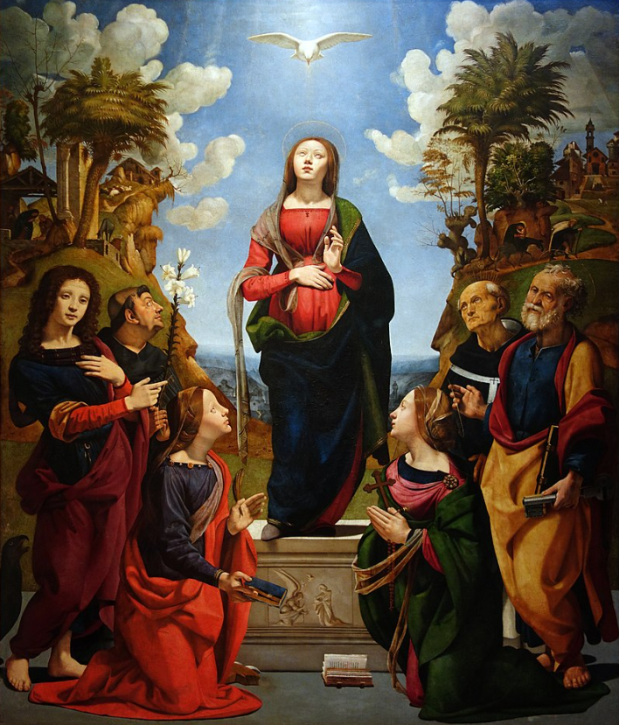
Many artists in the 15th century faced the problem of how to depict an abstract idea such as the Immaculate Conception, and the problem was not fully solved for 150 years. The Italian Renaissance artist Piero di Cosimo was among those artists who tried new solutions, but none of these became generally adopted so that the subject matter would be immediately recognizable to the faithful.

The definitive iconography for the Immaculate Conception, drawing on the emblem tradition, was established first through a vision of St. Beatriz de Silva Meneses. The Foundress of the Order of the Immaculate Conception, she experienced a vision of the Immaculate Conception, inspiring her devotion. Raised in the castle of Infante John, Lord of Reguengos de Monsaraz, she later accompanied Princess Isabel of Portugal to Castile. Due to her beauty, Queen Isabel imprisoned Beatriz in a tiny cell out of jealousy. In despair, Beatriz prayed to Our Lady and received a vision, assuring her life’s preservation. In this vision, the Virgin is dressed in white with a blue mantle, carrying the Child Jesus, stepping on a huge serpent dragon. The Blessed Mother said to St. Beatriz, “My daughter, you shall not die. I will preserve your life so that you may accomplish what you have so longed for. You will found a great religious order under the title of the Immaculate Conception; its daughters will wear a habit similar to my garments, and will dedicate themselves to serving God, in union with Me.” Following her release, she founded the Conceptionist nuns, dedicated to the Immaculate Conception. Beatriz forgave the Queen, withdrew from court intrigues, and established the order in 1484.

The painter and theorist Francisco Pacheco would later come across the life of St. Beatriz de Silva Meneses which would influence him to formulate the popular iconography of the Immaculate Conception. Pacheco’s iconography influenced other Spanish artists such as Bartolomé Murillo, Diego Velázquez, and Francisco Zurbarán, who each produced several artistic masterpieces based on the use of these same symbols.

The popularity of this particular representation of The Immaculate Conception spread across the rest of Europe, and has since remained the best-known artistic depiction of the concept: in a heavenly realm, moments after her creation, the spirit of Mary (in the form of a young woman) looks up in awe at (or bows her head to) God. The moon is under her feet and a halo of twelve stars surrounds her head, possibly a reference to “a woman clothed with the sun” from Revelation 12:1–2. Additional imagery may include clouds, a golden light, and cherubs. It is also notable that most depictions of the Virgin wear white and blue robes and wear no veil. In some paintings, cherubs are holding lilies and roses, flowers often associated with Mary.
The Spanish devotion to La Inmaculada
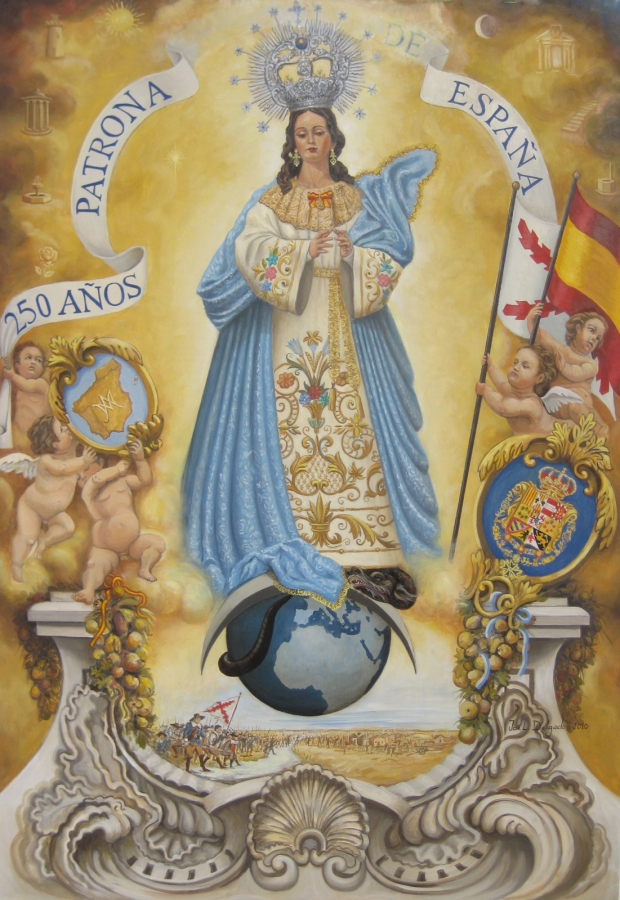
Spain has long exhibited a strong devotion to the Immaculate Conception, evident in early feasts and artistic expressions. The Feast of the Immaculate Conception dates back to the seventh century, gaining popularity in the thirteenth and spreading widely in the fifteenth century, particularly after the recovery of southern territories by Castile. In the 16th century, confraternities dedicated to the Pure and Clean Conception of Mary proliferated.
During this time, Spanish monarchs, clergy, and nobles presented numerous embassies to the Pope, seeking formal recognition of the immaculist doctrine. While the Dogma awaited formal declaration, successive Popes indirectly endorsed the doctrine, fostering devotion throughout Europe and Spanish-Latin American territories.
The 17th century marked the zenith of immaculist fervor, with cities like Valladolid and Seville exemplifying strong devotion. Liturgical feasts, associations, brotherhoods, and artistic expressions flourished during this period. Huelva became the first Spanish city to dedicate a temple to the Immaculate Conception.
During these years, various entities, including the University of Toledo, made Immaculate vows, with other significant universities and cities following suit. The 18th and 19th centuries saw fluctuations in the strength of devotion due to influences from French ideas and wars in Spain, causing challenges for religious groups. Despite difficulties, Charles II declared the Immaculate Virgin Patron Saint of Spain in 1760, and in 1800, all Spanish universities were obligated to swear an oath in defense of the Immaculate Conception.
Notable Marian apparitions
With the ongoing developments of the devotion and dogmatic definition of Mary’s Immaculate Conception at that time, three notable Marian apparitions further helped the dogmatic definition and popular devotion to the Immaculate Conception.

In the Guadalupe apparitions of 1531, after St. Juan Diego unraveled his tilma and revealed the miraculous picture of the Blessed Virgin as what he had seen since December 9, 1531. A few days later, After a few days, St. Juan Diego, accompanied by Spanish clergy, officers, and new converts to his home to check on his uncle Juan Bernardino who was at that time dying. All of them were amazed when they saw Juan Bernardino in robust health and he too was graced with an apparition of Our Lady. The Virgin cured him and revealed that she wished that the image would be known as “Santa Maria de Guadalupe”. The title Guadalupe that Juan Bernardino revealed might have been mistranslated by the Spaniards for it is believed that what the Virgin actually wished to be called “Santa Maria de Tecoataxopeuh” which literally means “The one who crushes the head of the Serpent”, a prologue of the confirmation of her Immaculate Conception. St. Juan Diego was canonized in 2000 by Pope St. John Paul II.

In Rue de Bac, Paris, France in 1830, The Blessed Virgin appeared to St. Catherine Laboure, a Vincentian novice at that time, and gave a series of messages and prophecies regarding the importance of the Sacraments, Marian devotion, and the future of France, most specifically the French Revolution that happened a few years later. Several months later, on November 27, 1830, she received a message detailing the designs for a medal, later known as the Miraculous Medal, now reproduced over a billion times and distributed around the world. The Miraculous Medal was also known as the Medal of the Immaculate Conception because of the inscription that was written surrounding the first phase of the medal: “O Mary conceived without sin, pray for us who have recourse to you.” The apparition was investigated in 1836 and later approved. Catherine worked for 46 more years in the hospices of her congregation until she died in 1876. Her body lies incorrupt at the site of the apparition to this day. She was canonized by the Church in 1947.

Years after the dogma of the Immaculate Conception was proclaimed in 1854, the dogma gained additional significance from the apparitions of Our Lady of Lourdes in 1858. At Lourdes, a 14-year-old girl, St. Bernadette Soubirous has seen the Blessed Virgin Mary eighteen times and called for penance and prayer for the conversion of sinners. On March 25, 1858, the Blessed Virgin introduced herself when St. Bernadette asked for her identity: “I am the Immaculate Conception”. This declaration from the Blessed Virgin confirms the dogmatic definition of her pure conception. After a 4-year investigation commission, the bishop of the Diocese of Tarbes declared on January 18, 1962: “We judge that Mary Immaculate, Mother of God, really appeared to Bernadette Soubirous on February 11, 1858, and on subsequent days, eighteen times in all. The faithful are justified in believing this to be certain.” St. Bernadette Soubirous later entered religious life and died in 1879 due to tuberculosis of the bone. Her body was exhumed in 1925 and found to be incorrupt. She was beatified in 1925 by Pope Pius X and was later Canonized on December 8, 1933, by the same Pontiff on the Feast of the Immaculate Conception.
The Formal Dogmatic Definition

Although the belief that Mary was sinless, or conceived with an immaculate soul, has been widely held since Late Antiquity, the doctrine was not dogmatically defined until 1854, by Blessed Pope Pius IX in his Papal Bull “Ineffabilis Deus”. which states:
“We declare, pronounce and define that the doctrine which asserts that the Blessed Virgin Mary, from the first moment of her conception, by a singular grace and privilege of almighty God, and given the merits of Jesus Christ, Savior of the human race, was preserved free from every stain of original sin is a doctrine revealed by God and, for this reason, must be firmly and constantly believed by all the faithful.”
The Church celebrates the Solemnity of the Immaculate Conception on December 8; in many Catholic countries, it is a holy day of obligation or Patronal feast, and in some a national public holiday.
The devotion to “La Inmaculada” in the Philippines
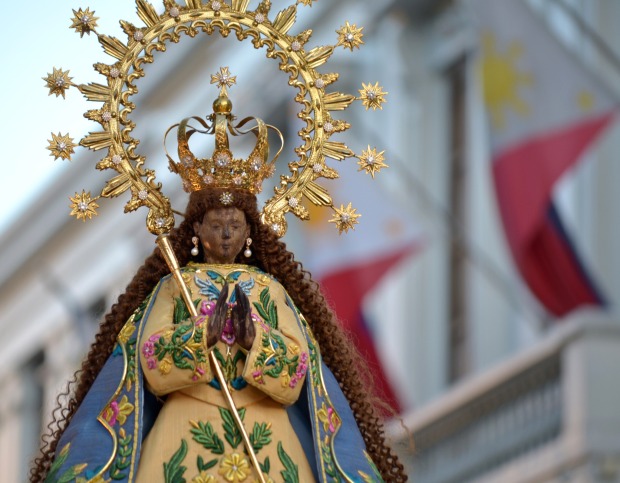
The Philippines, like numerous other countries, has been consecrated under the Patronage of the Immaculate Conception since the early days of Spanish colonization. It appears that the devotion and patronage of Our Lady as the Immaculate Conception were noticeable in various circumstances during the initial years of the conquest and beyond.
Ferdinand Magellan’s expedition in 1521 included a ship aptly named “Concepcion” when he embarked on the journey to discover the Spice Islands, ultimately leading to the discovery of the Philippines. Fast forward 50 years, during Miguel Lopez de Legazpi’s era, one of his soldiers stumbled upon the image of Nuestra Señora de Guia in a pandan bush, revered by the locals. This image was later enshrined in a chapel, now recognized as an Archdiocesan Shrine. Nuestra Señora de Guia, the first image of the Immaculate Conception in the country, earned the title of the Sworn Patroness of Manila due to its historical significance and connection to the Spanish colonial era.
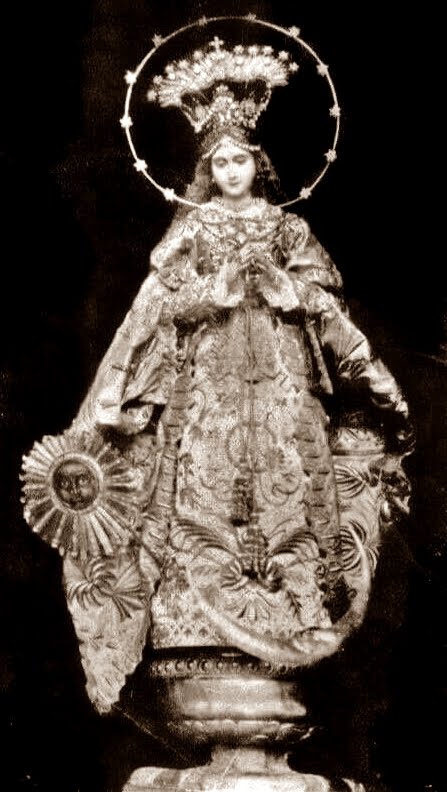
On the other hand, the Church of Old San Francisco of the Franciscans in Intramuros, administered by the Franciscan Order, was once the center of the devotions to the Immaculate Conception, and the beautiful image was one of the most venerated in the country, Unfortunately, the image and the Church were destroyed during the Second World War.
Since the early days, although the pious belief in Mary’s Immaculate Conception was not yet defined dogmatically, the Filipinos held this belief for centuries, and before the term “Inmaculada” was used, the Filipino faithful would refer to the Virgin as “La Purisima”. The usage of the term is evident with the images of the Immaculate Conception in some provinces in the country that still use the term “Purisima”, like those of Santa Maria, Bulacan.
In his Papal Bull “Illius fulti praesidio”, dated February 6, 1578, Pope Gregory XIII established the diocese of Manila and decreed that its cathedral should be under the invocation of the Conception of the Blessed Virgin Mary. The same invocation was given to the cathedrals of Nueva Segovia and Cáceres by Pope Clement VIII by decree of August 13, 1595.
The Philippine Iconography of La Inmaculada
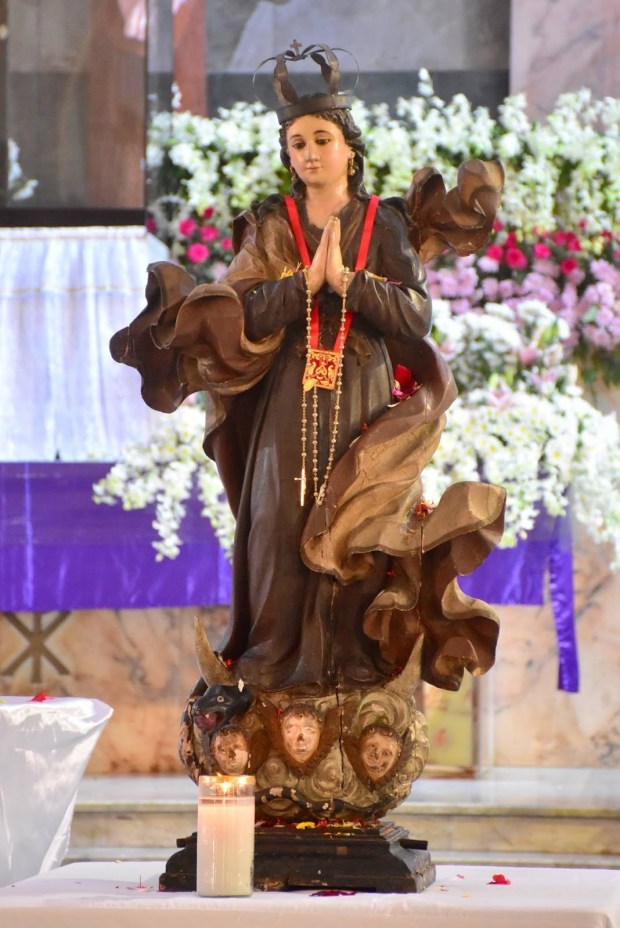
In the Philippine setting, there were at least three types of images of the Immaculate Conception that are commonly seen in the country, first is the Murillo style where the image was done in a de tallado style of carving that mimics those of the painting of Murillo, though often times the windblown effects on the dress of the Virgin adds to the dramatic presentation of the Virgin Best examples of these are the Inmacaluada Concepcion de Malabon and Nuestra Señora de Triunfo de la Cruz of Ozamiz City).

Another popular depiction of the Immaculate Conception is that the Virgin is standing upright while crushing the serpent, her hands clasped in prayer or held together, the face either looking down or looking to the beholder, wearing an intricate vestment, mostly a de bastidor vestment (A vestment with a wide opening) and sports a crown, a scepter, the diagnostic doce estrellas and oftentimes, a rostrillo.
Oftentimes, the palikpik is utilized like those of the La Purisima Concepcion of Santa Maria, Bulacan, and the Festejada image of the Intramuros Administration. Other images on the other hand use the verdugado cut, with the absence of the Palikpik like those of Nuestra Señora de la Paz y Buen Viaje of Antipolo, Rizal, and Nuestra Señora de Caysasay of Taal, Batangas.

Between the 19th to the 20th Centuries, a different iconography emerged, most specifically during the celebration of the 50th anniversary of the dogmatic proclamation of the Immaculate Conception by St. Pius X in 1904. For this type, the Virgin wears a blue long mantle, looking downwards and her hands in a prayer position. Such examples can be found in the images of La Inmaculada Concepcion de Pasig of Pasig Cathedral and the La Purisima Concepcion “Ang Birhen sa Patio” of the Diocesan Shrine and Parish of St. Augustine, Baliuag, Bulacan.
The lasting devotion

In towns throughout the country where a miraculous image of the Immaculate Conception is venerated, numerous stories recount miracles and diverse manifestations of the Inmaculada across the centuries. These tales involve instances of safeguarding towns from natural disasters and plagues, restoring the health of individuals, making nocturnal visits to devoted followers, guiding travelers on their journeys, and even foreseeing the country’s economy.
It is from these circumstances that various images of the Immaculate Conception received new titles. Noteworthy examples include Nuestra Señora de la Paz y Buen Viaje of Antipolo, an image of the Immaculate Conception, which gained a special status due to her assistance in the Manila-Acapulco Galleon Trade; Nuestra Señora de la Inmaculada Concepcion de Caysasay of Batangas, renowned for a series of appearances to devotees; Nuestra Señora de la Inmaculada Concepcion de Salambao of Obando, Bulacan, recognized for aiding in childbirth; and Nuestra Señora del Pronto Socorro of Marinduque, celebrated for saving Marinduque from pirates and providing immediate relief to the people of Marinduque, among others.
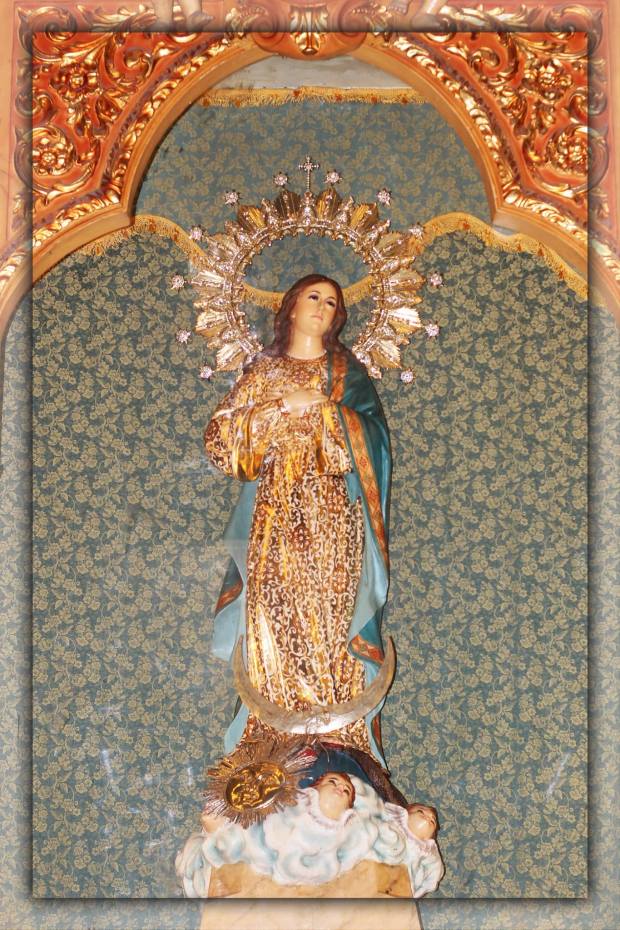
The image of La Inmaculada Concepcion of the Diocesan Shrine of the Immaculate Conception in Naic, Cavite, holds significance as historians believe its mythical sun at her feet might have inspired General Emilio Aguinaldo’s design for the first official flag of the Republic. During his stay in Naic, Aguinaldo passed by the church frequently, and the sun featured in the second official revision of the Philippine flag is thought to have drawn inspiration from the image of the Immaculate Conception. The Naic conference in the parish convent led to the replacement of the old Tagalog letter on the flag with a “Sun of Liberty” featuring symbolic eight rays and facial features. This sun appeared on the first version of the Philippine flag raised on June 12, 1898, in Alapan and later in Kawit, Cavite.
Other images of the Immaculate Conception were also known for being miraculous and devotions and pilgrimages to these shrines were proven to be popular as well, notably Nuestra Señora de Agua Santa of Los Baños, Laguna, La Inmaculada Concepcion of Cebu Cathedral, La Inmaculada Concepcion de Dasmariñas of Dasmariñas, Cavite, Nuestra Señora de Triunfo de la Cruz of Ozamiz City, Misamis Occidental, La Inmaculada Concepcion of Batanes, La Virgen de Porteria de Majayjay of Majayjay, Laguna, La Inmacaluda Concepcion de Baclayon of Baclayon, Bohol, Nuestra Señora de Namacpacan of Luna, La Union, Virgen de Salawag of Salawag, Dasmariñas, Cavte among others.
Patronage in the Philippines
After the Philippines ceased to become a Spanish colony, the first Provincial Council of Manila petitioned the Holy See for the privilege to continue using blue vestments for the Feast of Immaculate Conception. Pope Pius X granted this request via in a special audience, with the privilege included in a list of indults granted to the Philippines, dated February 11, 1910, executed by Cardinal Rafael Merry del Val.
By the Apostolic Letter “Impositi Nobis” of September 12, 1942, Pope Pius XII, at the request of the bishops in the Philippines, declared the Virgin Mary under the title of the Immaculate Conception as Principal Patroness of the Philippines with Saints Pudentiana and Rose of Lima as secondary patronesses, mentioning that the 1907 Provincial Council of Manila invoked “Maria Immaculata” as patroness of the whole Filipino people and that historical documents indicated Saint Pudentiana as Patroness of the Philippines from the 16th century and Saint Rose of Lima from the 17th.
The bull only affected those patronesses of the Philippines that were Ordinally ranked. Since 1571, Saint Pudentiana was the principal patroness of the Philippines; and since 1670, Saint Rose of Lima was the principal patroness of the Indies, thereby also becoming a de jure principal patroness of the Philippines. These two patronesses later became the official Secondary Patroness of the country in deference to the Immaculate Conception.
The Enduring Devotion
The Philippines celebrated the 1954 Marian year by releasing a commemorative stamp featuring an image of the Immaculate Conception, another postal stamp was re-issued in 1958 as well. On March 29, 2017, the Philippine government through the House of Representatives approved Bill # 5241 declaring December 8 as a non-working official holiday in honor of the Blessed Virgin Mary as patroness of its country. As of this writing, the Bill is for approval of the Senate and for signature of the President of the Philippines.
Among various fiestas and rituals honoring the Immaculate Conception’s patronage is the annual Grand Marian Procession in Manila that began in 1980, where various statues of the Virgin Mary depicting her different titles and apparitions are borne in procession. The images are brought to Intramuros from their respective shrines and private homes to join the annual event.

The Grand Marian Procession became an avenue to propagate the devotion to the Blessed Virgin Mary under her different titles and sobriquets that are venerated in different shrines in the country. The event is administered both by the Cofradía de la Inmaculada Concepción and the Intramuros Administration, in cooperation with the City Government of Manila and the Roman Catholic Archdiocese of Manila.

The Importance of devotion to the Inmaculada
The Immaculate Conception is a celebration of God’s victory over sin and death. In Mary, the ever-Immaculate Virgin, we profess that the true destiny of humankind and the world is to live fully in God’s love where sin and death, and the forces that surround it, no longer exist. In our own lives, the Immaculate Conception becomes a symbol of the divine reality present in everyone at the core of one’s being, where one experiences God’s graceful presence.
In our present times, where we face different adversities in our everyday life, as a nation and people of God, the Mary, the Ever Immaculate Mother of God is our rallying force that we cling to in our struggles. Her presence reminds us that God is always with us and empowers us to commit ourselves to the work of goodness – the one thing that we need to imitate from our Patroness.
iAve Maria Purisima, sin peccado concebida!
La Inmaculada Concepcion, Patrona Principal de Filipinas, iRuega por nosotros!
Reference:
Acta Apostolicae Sedis 28 (1936), pp.63f. – 16 Iulii (July) 1935. Pius XI. Beatissima Virgo Maria Sub Titulo de Guadalupa Insularum Philippinarum Coelestis Patrona Declaratur – “Archived copy”. Archived from the original on April 3, 2014. Retrieved November 30, 2017
“Ang Mahal na Birhen: Mary in Philippine Life Today”. Cbcponline.net. Retrieved May 27, 2017.
Aviado, Lutgarda , Madonnas of the Philippines, Manlapaz Press, Quezon City, 1972.
Barcelona, Mary Anne, Ynang Maria: a celebration of the Blessed Virgin Mary in the Philippines. Ed. Consuelo B. Estampa, P.D. Pasig City, Anvil Publishing Inc, 2004.
“Dei praesidio fultus: Liturgical blue”. Siniculus. 2014-12-30. Retrieved October 28, 2017.
Insularum Philippinarum Beatissima Virgo Maria Titulo Immaculata Conceptio Primaria Universalisque Patrona et Sanctae Virgines Pudentiana ac Rosa Limana Patronae Secundarias Declarantur – Acta Apostolicae Sedis (1942) Pages 336-337
“Dei praesidio fultus: Philippine Bullary I”. Siniculus. 2013-05-30. Retrieved May 27, 2017.
“Dei praesidio fultus: Protectresses of the Philippines”. Siniculus. 2013-05-11. Retrieved October 28, 2017.
Delos Reyes, Michael P., Salve Regina: On Crowning image of the Virgin Mary, Diliman, Quezon City, Claret Communications Foundation Inc.,2015.
Le Franc, Martin. The Conception of Mary — A Rhyming Translation of Book V of Le Champion des Dames by Martin Le Franc (1410-1461). Ed. and trans. Steven Millen Taylor. Lewiston, New York: The Edwin Mellen Press, 2010.
Sanchez, Francisco, La Virgen Maria Venerada en sus Imagenes Filipinas, Manila: Imp. De Santos y Bernal, 1904.
